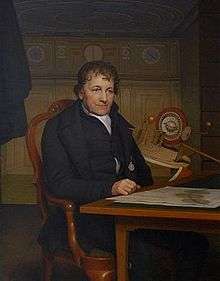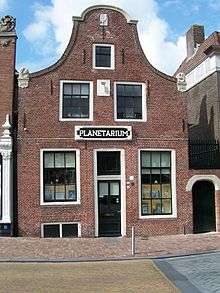Eise Eisinga
| Eise Eisinga | |
|---|---|
 Portrait by Willem Bartel van der Kooi (1827) | |
| Born |
Eise Jeltes Eisinga 21 February 1744 Dronrijp, Dutch Republic |
| Died |
27 August 1828 (aged 84) Franeker, Netherlands |
Eise Jeltes Eisinga (21 February 1744 – 27 August 1828) was a Frisian amateur astronomer who built the Eise Eisinga Planetarium in his house in Franeker, Frisia Province in the Netherlands. The orrery still exists and is the oldest functioning planetarium in the world.
Biography
Eise Jeltes Eisinga was born on 21 February 1744 in Dronrijp in the Dutch Republic. He was the son of Jelte Eises from Oosterlittens, a wool carder, and Hitje Steffens from Winsum.
Although Eisinga was moderately gifted, he was not allowed to go to school. When he was only 17 years old he published a book about the principles of astronomy. Eisinga became a wool carder in Franeker, Netherlands. Through self-education he mastered mathematics and astronomy, which he also studied at the Franeker Academy. At the age of 24 he married Pietje Jacobs (? – 24 July 1788) and they had three children, one girl and two boys.
- Trijntje (April 1773 – 26 April 1773)
- Jelte (29 May 1774 – 31 March 1809)
- Jacobus (17 March 1784 – 24 March 1858)
Due to a political crisis in 1787, he had to leave Friesland and went to Germany. Later he moved to Visvliet where he worked as a wool comber. He was banned from Friesland for five years and therefore stayed in Visvliet just across the border in Groningen. Meanwhile his wife died, and on 27 May 1792 he married Trijntje Eelkes Sikkema (21 February 1764) in Visvliet. They had one son and two daughters.
- Eelke (14 October 1793 – 28 May 1795)
- Hittje (16 February 1796 – 8 May 1843)
- Minke (4 June 1798 – 17 July 1870)
In 1795 he returned to Franeker.
Eisinga became a professor at the Franeker Academy, until 1811 when Napoleon ordered it to be closed.
Eisinga died on 27 August 1828, at the age 84, in Franeker.
Orrery

On 8 May 1774 a conjunction of the moon and the planets Mercury, Venus, Mars, Jupiter was forecast to appear. Reverend Eelco Alta, from Boazum, Netherlands, published a book in which he interpreted this as a return to the state of the planets at the day of creation and a likely occasion for Armageddon. Alta predicted that the planets and the moon would collide, with the result that the earth would be pushed out of its orbit and burned by the sun.[1] Due to this prediction there was a lot of panic in Friesland.
The canonical view holds that Eisinga decided to build an orrery in his living room to prove that there was no reason for panic. He expected to finish it within six months and eventually finished it in 1781, seven years after he started. During the same year Uranus was discovered, but there was no room for this planet on the ceiling of his living room, where the orrery was located. However, recent research indicates that this chain of causality is dubious, not in the last place because Eijsinga appears to have commenced construction before the publication of Alta's book.[2] The construction of the orrery saved Eijsinga a lot of time, however, because he no longer needed to calculate the planets' respective positions by hand.
On 30 June 1818 King William I of the Netherlands and Prince Frederik visited the orrery. King William I bought the orrery for the Dutch state. In 1859 the orrery was donated by the Dutch state to the city of Franeker.
Recognition
Eisinga was rewarded by becoming an honorary citizen of Franeker. The street of his planetarium was renamed "Eise Eisingastraat". On 5 May 1994 an 80 cent stamp was issued by the post office to celebrate his 250th birthday. In 2006 the planetarium was given permission to use the title "royal". Also in 2006 Eise Eisinga was included in the Canon of Dutch History which is taught in schools in the Netherlands.
References
- ↑ [Eelco Alta. Philosophische Bedenkingen over de Conjunctie van de Planeten Jupiter, Mars, Venus, Mercurius en de Maan. Op den Agtsten May 1774. staande te gebeuren, en wel over de Mogelyke en Waarschynelyke Sterre en Natuurkundige Gevolgen deezer Conjunctie. Boazum, 1774.]
- ↑ Huib J. Zuidervaart, Speculatie, wetenschap en vernuft. Fysica en astronomie volgens Wytze Foppes Dongjuma (1707-1778), instrumentmaker te Leeuwarden (Leeuwarden: Fryske Akademy, 1995).
Further reading
- Havinga, E.; van Wijk, W. E.; d'Aumerie, J. F. M. G. (1928). Planetarium-boek: Eise Eisinga (in Dutch). Arnhem: Van Loghum Slaterus.
- Terpstra, Pieter (1994). Wolken en stjerren; roman oer Eise Eisinga (in Frisian). ISBN 90-330-0237-X.
External links
 Media related to Eise Eisinga at Wikimedia Commons
Media related to Eise Eisinga at Wikimedia Commons